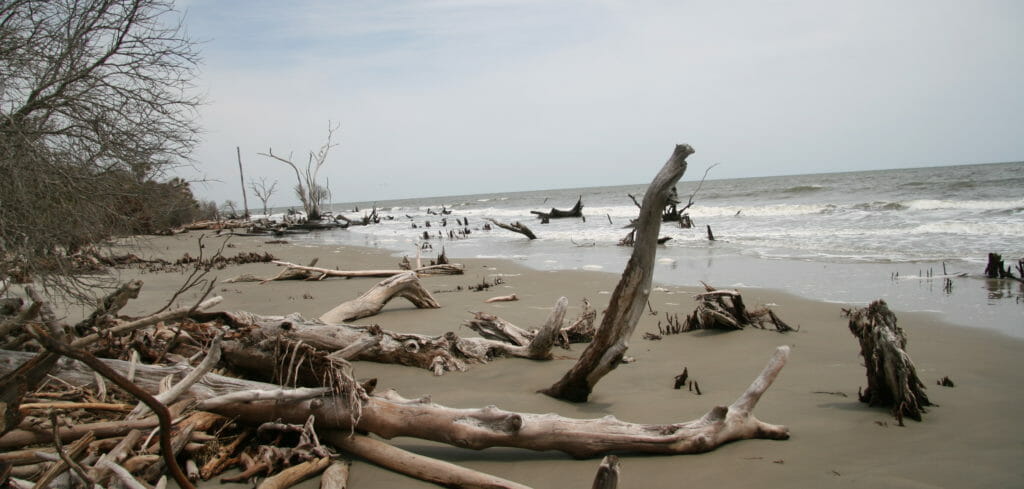Cost of Rising Seas Could Reach $27 Trillion a Year by 2100
In 80 years, the global cost of rising seas could be at astronomical levels, with the oceans nearly two meters higher than now. The sea is encroaching on Boneyard Beach in South Carolina at 25 to 30 feet a year. (Stacy Shelton / Wikimedia Commons)
The sea is encroaching on Boneyard Beach in South Carolina at 25 to 30 feet a year. (Stacy Shelton / Wikimedia Commons)
The rising seas’ cost may be $27 trillion a year in U.S. dollars for the world by 2100 if it fails to meet the UN’s 2ºC global warming limit by then, with sea level rise of, at its worst, almost six feet (nearly two meters), new research says.
A study led by the UK’s National Oceanography Centre (NOC) says the worldwide cost of flooding caused by rising sea levels, at their median level, could by 2100 be $14 trillion, if governments miss the United Nations target of keeping the rise in global temperatures, caused by unremitting fossil fuel use, to less than 2ºC above pre-industrial levels. But the extent and cost could be much higher.
The target was agreed by 195 nations in Paris in 2015, with many politicians and most scientists urging them to treat 2ºC as a more modest and feasible limit while aiming if possible for 1.5°C. The cuts in greenhouse gas emissions already promised through the UN Framework Convention on Climate Change are not yet enough to achieve the 2ºC limit, let alone the more stringent figure, and much deeper cuts will be needed.
The researchers also found that it was upper-middle income countries such as China that would see the largest increase in flood costs, while the richest ones would suffer the least, because of the high levels of protection infrastructure they already enjoyed. The research is published in the journal Environmental Research Letters.
Svetlana Jevrejeva of the NOC is the study’s lead author. She said: “More than 600 million people live in low-elevation coastal areas, less than 10 meters above sea level. In a warming climate, global sea level will rise due to the melting of land-based glaciers and ice sheets, and from the thermal expansion of ocean waters. So sea level rise is one of the most damaging aspects of our warming climate.”
The researchers explored the pace and consequences of global and regional sea level rise under warming limited to both 1.5 ºC and 2 ºC, and compared their findings with projections for unmitigated warming.
Using World Bank income groups (high, upper-middle, lower-middle and low-income countries), they then assessed the impact of sea level rise in coastal areas from a global perspective.
Steep Increase
Dr Jevrejeva said: “We found that with a temperature rise trajectory of 1.5°C, by 2100 the median sea level will have risen by 0.52m (1.7ft). But, if the 2°C target is missed, we will see a median sea level rise of 0.86m (2.8ft), and a worst-case rise of 1.8m (5.9ft).”
If warming was not mitigated the global annual flood costs without adaptation would increase to $14tn annually for the median sea level rise of 0.86m, and up to $27tn per year for 1.8m. This would account for 2.8% of global GDP in 2100.
The conclusions she and her colleagues reached sound hair-raising and possibly far-fetched. But an earlier study put the possible global cost by 2100 of coastal flooding at nearly four times more than the NOC team – $100tn.
Another group of researchers suggested that if global warming continued at its present rate it could start a process in Antarctica which would lead ultimately to sea level rise of almost three metres.
Impact on Tropics
The projected difference in coastal sea levels is also likely to mean that tropical areas will see very high sea levels more often, the study says.
“These extreme sea levels will have a negative effect on the economies of developing coastal nations, and the habitability of low-lying coastlines,” said Dr Jevrejeva.
“Small, low-lying island nations such as the Maldives will be very easily affected, and the pressures on their natural resources and environment will become even greater.
“These results place further emphasis on putting even greater efforts into mitigating rising global temperatures.”
Your support is crucial...As we navigate an uncertain 2025, with a new administration questioning press freedoms, the risks are clear: our ability to report freely is under threat.
Your tax-deductible donation enables us to dig deeper, delivering fearless investigative reporting and analysis that exposes the reality beneath the headlines — without compromise.
Now is the time to take action. Stand with our courageous journalists. Donate today to protect a free press, uphold democracy and uncover the stories that need to be told.






You need to be a supporter to comment.
There are currently no responses to this article.
Be the first to respond.